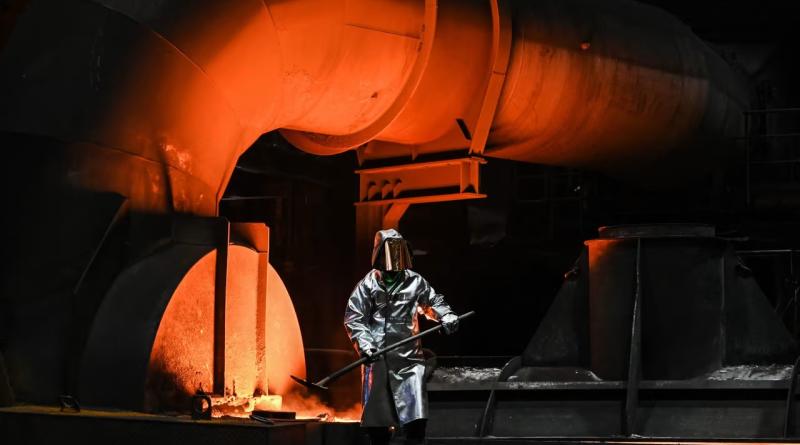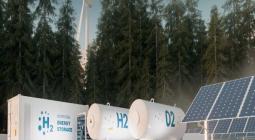Go big or go green? The EU’s massively expanding hydrogen bet

Brussels is pumping ever-increasing amounts of cash into hydrogen projects, and dragging its feet on climate standards for the gas.
This article is part of the European Union, Inc special report.
Two back-to-back crises have pushed Europe to bet increasing amounts of cash on a hydrogen revolution to meet industrial ambitions and reduce carbon emissions. But its promise to keep its economy growing while meeting 2050 climate targets looks increasingly tenuous.
For the hydrogen industry, it’s a subsidy boom. European Commission President Ursula von der Leyen is promising a €3 billion investment vehicle, dubbed a hydrogen bank, to “help guarantee the purchase of hydrogen” by spurring demand using cash from the EU Innovation Fund.
That comes on top of more than €13 billion in state aid approvals for national and cross-border projects so far: €5.4 billion for Hy2Tech, a cross-border initiative to perfect the technology; €5.2 billion for Hy2Use, aimed at applications in hard-to-decarbonize sectors such as steel, cement and glass; more than €2 billion for German projects in steel, chemicals and production abroad; €220 million for a Spanish plant, and €194 million for a Romanian plant.
Two more cross-border state aid hydrogen schemes — dubbed Important Projects of Common European Interest — are also in the works, to focus on infrastructure and mobility, though amounts have yet to be released.
Regulators aren’t quite sure how to spend this bonanza.
For the hydrogen bank, “we’re looking at various ways it should be shaped, all options are still on the table,” said Justin Rosing from the Commission’s energy department at the World Hydrogen Congress on October 12. “The initial idea is to look at contracts for difference” to bridge the gap between the cost of hydrogen producers’ need and what buyers are willing to pay. “The initial focus is on domestic production, but we need to look at imports ... so we’re really at the initial stage of exploring it,” Rosing added.
€430 billion recovery pitch
Before May 2020, there was no such thing as a standalone EU hydrogen strategy. Hydrogen was mentioned only as a complement to rolling out renewable energy and better power grid connections in the Commission’s Green Deal plans.
Only when the coronavirus crisis threatened to derail those green dreams in early 2020, did the Commission move swiftly to prioritize hydrogen, according to Jorgo Chatzimarkakis, CEO of industry lobby Hydrogen Europe.
“The crisis broke out, there was a pressure on policymakers to deliver right away, to mobilize the funds needed for a green recovery,” he recalled. “We were very, very fast in reacting to what the Commission needed ... we came back to them in May with a concrete plan.”
That industry road map called for 40 gigawatts (GW) of electrolytic capacity to be built across the EU by 2030, to use renewable electricity to jolt hydrogen out of water. A further 40 GW of production capacity would also be built abroad with the hydrogen then imported by the EU.
Those plans had a €430 billion price tag over a decade.
“Now, the moment we presented that number to the Commission, you should have seen their eyes, the way they reacted,” said Chatzimarkakis. “But it was not, ‘Crap that’s crazy.’ It was, ‘How do you break this down, how do you do that math?’”
Hydrogen Europe backed up its estimates with a letter signed by 81 chief executives of European firms, pledging they were willing to invest in the plan if the Commission were to set up a “clean hydrogen alliance” to facilitate projects, similar to previous initiatives for batteries.
It worked.
By July 2020, the Commission had a hydrogen strategy, an industry alliance and a target to produce 10 million tons of renewable hydrogen in the region over the next decade.
The costs were calculated as up to €470 billion for renewable hydrogen by 2050 — and as much as €18 billion for hydrogen made by chemically stripping then-cheap natural gas and capturing escaping CO2 emissions, as an intermediate production process until the price of renewable hydrogen came down.
There was a long way to go. Last year hydrogen accounted for 2.5 percent of the world’s final energy demand and was responsible for 2.5 percent of global CO2 emissions.
The Commission aimed to boost hydrogen’s share to 14 percent of the EU’s final energy demand by 2050 — and pay to have existing polluting production methods mitigated with nascent CO2 capture techniques before being replaced down the road with the water-and-electrolysis method.
It was a controversial choice that has dogged the Commission ever since.
Green promise imperiled
In late 2021, a high-profile study compared the emissions of making hydrogen from natural gas using CO2 capture techniques to those from burning coal, prompting a massive outcry over the EU plan, which had pitched the method as low-carbon.
Energy Commissioner Kadri Simson told POLITICO that regulators were focused on scaling up “both production and consumption, and that was the reason when we presented our hydrogen strategy ... it was covering both renewable hydrogen and low-carbon.”
That market-making rationale drew the ire of climate activists, including Sweden’s Greta Thunberg. “If nothing else, at least it’s refreshingly honest,” Thunberg tweeted.
Skyrocketing gas prices since the Russian invasion of Ukraine have eliminated the argument that it was necessary to fund gas-based hydrogen until large-scale renewable production sites got up and running.
The Commission’s response to the latest energy-supply crunch has been to adopt more of the industry’s plans: The REPowerEU strategy, released earlier this year, proposes weaning the bloc off Russian oil and gas by not only making its own hydrogen, but importing 10 million more tons by 2030 from “reliable suppliers” across the globe.
And there’s a new threat to hydrogen’s green climate credentials: The Commission is considering draft legislation that would not require strict proof that the machines used to jolt hydrogen out of water are solely powered by new renewable energy installations until 2027.
That would mean that electrolysis machines plugged into the local power grid might, at times when it’s cloudy or not windy, be running on electricity coming from natural gas or coal.
Climate Action Network Europe and other climate change campaigners warned von der Leyen that scrapping the strict energy reporting requirements risked making the nascent hydrogen economy “a subsidy-bloated and inefficient market that result[s] in disastrous unintended consequences for the environment and climate.”
The legislation is already a year behind schedule. This month, Hydrogen Europe urged von der Leyen to act — and to further relax the rules by pushing the strict renewable reporting requirements to 2028 and allowing all first-mover projects making hydrogen out of water to benefit from an additional 10 years of looser green rules.
“Reducing policy uncertainty now for renewable hydrogen is paramount if Europe does not want to lose global leadership,” the letter warns.
Global leadership mirage
According to the International Energy Agency, the EU is still only halfway to meeting its own production targets.
“Based on the current project pipeline, low-emissions hydrogen production from water electrolyzers in Europe could reach close to 5 million tons of hydrogen by 2030,” the IEA’s September Global Hydrogen Review 2022 report reads.
But even with more flexible green reporting rules to ramp up more projects, the EU has a long way to climb if the goal is to be the global No. 1.
China still leads the hydrogen market, followed by the U.S. and the Middle East. The EU is fourth, just ahead of India, according to data from BloombergNEF, and production costs for electrolyzer systems are four times higher in Europe than in China.
But according to Chatzimarkakis — who is “extremely happy to see that our European campaign to make hydrogen big is working,” even if it means that EU-based firms are now being tempted by sweeter tax credits in the U.S. — there’s still time for Europe to speed ahead.
That is, if von der Leyen is willing to up the ante. “The €3 billion for the hydrogen bank … I tend to interpret the €3 billion as an annual contribution,” he said with a smile.
Pietro Lombardi contributed reporting.
cover photo: An employee works at the blast furnace at the ThyssenKrupp plant in Duisburg, western Germany | Ina Fassbender/AFP via Getty Images





